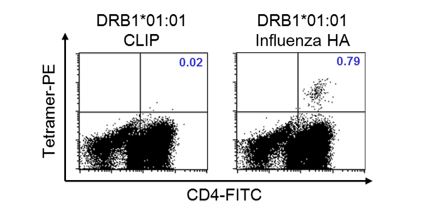MHC Class II Tetramers
T cell receptors (TCRs) expressed on the surface of T cells specifically recognize and bind to complexes of major histocompatibility complex (MHC) molecules and peptide fragments. CD4+ T cells, which include helper and regulatory T cells, recognize complexes of MHC Class II molecules and peptide.
CD4+ T cells play an important role in health and diseases. Analysis of these cells has long been hampered by a lack of suitable assays. MHC Class II tetramers have become an important tool to investigate rare antigen-specific CD4+ T cells such as CD4+CD25+ regulatory T cells. In addition to monitoring disease progression and therapeutic intervention, MHC Class II tetramers can be used to study tolerance induction, vaccination efficacy, and autoimmunity.

MHC tetramers are complexes of four MHC molecules, associated with a specific peptide and bound to a fluorochrome. Class II tetramers bind to a distinct population of CD4+ T cells.
MHC class II tetramer staining is more technically challenging than class I tetramer staining. Some reasons for this include:
- Antigen-specific CD4+ T cells are more rare than antigen-specific CD8+ T cells
- Affinity between the T cell receptor and MHC/peptide complex is generally lower
- Acquisition of 100,000-200,000 CD4+ T cells is typically required
- Exclusion gating essential
- T cell expansion and/or pre-enrichment may be required
MHC Class II tetramers can be used to monitor antigen specific CD4+ T cell expansion after vaccination (Fig. 1) or after a natural immune response against a pathogen (Fig. 2).

CLIP tetramers: Negative controls in human class II tetramer assays
Negative tetramers are important in helping set the region or gate around antigen non-specific T cells to find the positive T cells. It would be especially effective if you are troubleshooting or intend to detect a small population of antigen specific T cells.
For negative control of Human class II allele, CLIP103-117 tetramers can be used. CLIP is a partial sequence of Ii (human class II associated Invariant chain). In antigen presenting cells, MHC class II molecules assemble in the ER with Ii. The CLIP segment of Ii binds the peptide biding groove of MHC class II molecules to protect the hydrophobic binding site. Following transport to the endosomal/lysosomal peptide-loading compartment, Ii is proteolytically cleaved, and the remaining CLIP peptide is exchanged with other peptides in a reaction catalyzed by HLA-DM. It is considered that there are no CD4+ T cells react with CLIP103-117 peptide.





